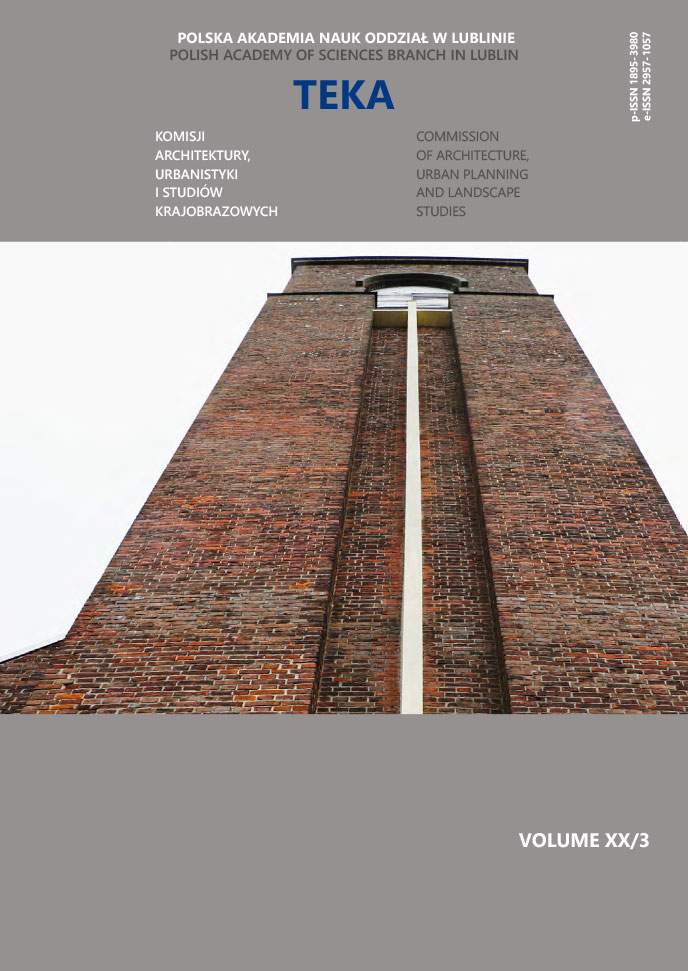The technology that meets modern human needs – criteria of assessment of smart home system
Dariusz Gaweł
dga@vp.plKatedra Architektury Współczesnej, Wydział Budownictwa i Architektury, Politechnika Lubelska (Polska)
https://orcid.org/0000-0001-5759-1962
Abstrakt
Artykuł jest podsumowaniem badań przeprowadzonych w celach edukacyjnych z udziałem studentów Politechniki Lubelskiej nad projektowaniem i użytkowaniem obiektów tworzonych jako dom inteligentny (SH). Rosnąca dostępność systemów wyposażenia inteligentnego budynku wiąże się z ich powszechnym stosowaniem i dostępną ceną. Nowe technologie, będące wynikiem postępu naukowo-technicznego umożliwiają wykorzystanie urządzeń do podniesienia standardu zamieszkania i użytkowania budynków. Tworzenie obiektów SH w dzisiejszych czasach nie ogranicza się tylko do budynków jednorodzinnych. Coraz częściej obserwujemy inteligentne budynki wielorodzinne i użyteczności publicznej. Jednocześnie jesteśmy świadomi projektowania obiektów samowystarczalnych energetycznie, które dają nam swobodę budowania na terenach niezainwestowanych.
Słowa kluczowe:
new technologies, human needs, SH smart home systemBibliografia
Bergeron F., Bouchard K., Gaboury S., Giroux S., Tracking objects within a smart home, Expert Systems With Applications, 113, 428−442, 2018.
DOI: https://doi.org/10.1016/j.eswa.2018.07.009
Google Scholar
Bin Zhou, Wentao Li, Ka Wing Chan, Yijia Cao, Yonghong Kuang, Xi Liu, Xiong Wang, Smart home energy management systems: Concept, configurations, and scheduling strategies, Renewable and Sustainable Energy Reviews, 61, 30−40, 2016.
DOI: https://doi.org/10.1016/j.rser.2016.03.047
Google Scholar
Careglio D., Fiore U., Ricciardi S., Sembroiz D., Planning and operational energy optimization solutions for smart buildings, Information Sciences, 476, 439−452, 2019.
DOI: https://doi.org/10.1016/j.ins.2018.06.003
Google Scholar
Cook D.J., De la Cruz G., Goel S., Minor B., Nesaei S., Pereyda C., Raghunath N., Schmitter-Edgecombe M., Wilson G., Robot-enabled support of daily activities in smart home environments, Cognitive Systems Research 2018.
Google Scholar
Darby S.J., Gram-Hanssen K., “Home is where the smart is”? Evaluating smart home research and approaches against the concept of home, Energy Research & Social Science, 37, 94−101, 2018.
DOI: https://doi.org/10.1016/j.erss.2017.09.037
Google Scholar
Ford R.,Karlin B.,Pritoni M.,Sanguinetti A., Categories and functionality of smart home technology for energy management, Building and Environment, 123, 543−554, 2017.
DOI: https://doi.org/10.1016/j.buildenv.2017.07.020
Google Scholar
Kumard P., Mazaheric M., Morawska L., Salthammer L.C., Salthammer T., Schiewecka A., Uhdea E., Smart homes and the control of indoor air quality, Renewable and Sustainable Energy Reviews, 94, 705−718, 2018.
DOI: https://doi.org/10.1016/j.rser.2018.05.057
Google Scholar
Lyanage C. De Silva, Morikawa C., Petra I.M., State of the art of smart homes, Engineering Applications of Artificial Intelligence, 25, 7,1313−1321, Elsevier 2012.
DOI: https://doi.org/10.1016/j.engappai.2012.05.002
Google Scholar
Mikulik J., Budynek inteligentny. Podstawowe systemy bezpieczeństwa w budynkach inteligentnych, vol 2, Wydawnictwo Politechniki Śląskiej, Gliwice 2010 (in Polish).
Google Scholar
Min Li, Wenbin Gu, Wei Chen, Yeshen He, Yannian Wu, Yiying Zhang, Smart Home: Architecture, Technologies and Systems, Procedia Computer Science, 131, 393−400, 2018.
DOI: https://doi.org/10.1016/j.procs.2018.04.219
Google Scholar
Niezabitowska E., Metody i techniki badawcze w architekturze, Wydawnictwo Politechniki Śląskiej, Gliwice (2015) (in Polish).
Google Scholar
Suriya Priya R. Asaithambi, Sitalakshmi V., Ramanathan V., Big Data and Personalisation for Non-Intrusive Smart Home Automation, MDPI Journal, 5, 6, 1−21, 2021.
DOI: https://doi.org/10.3390/bdcc5010006
Google Scholar
Tookey J., Omrani H., Fleury A., Naismith N., Ghaffarianhoseini M., Gaffarianhoseini A., Future of Smart Homes: Application of Intelligent Technologies towards Smaler Urban Future, IGI Global 2016.
Google Scholar
City of 2030 survey by Cite Research – November 2018 (2019), 30 July 2021, https://www.plastech.pl/wiadomosci/Urzadzenia-Smart-Home-beda-standardem-do-2030-roku-14192.
Google Scholar
Autorzy
Dariusz Gawełdga@vp.pl
Katedra Architektury Współczesnej, Wydział Budownictwa i Architektury, Politechnika Lubelska Polska
https://orcid.org/0000-0001-5759-1962
Statystyki
Abstract views: 153PDF downloads: 126
Licencja

Utwór dostępny jest na licencji Creative Commons Uznanie autorstwa – Na tych samych warunkach 4.0 Miedzynarodowe.




